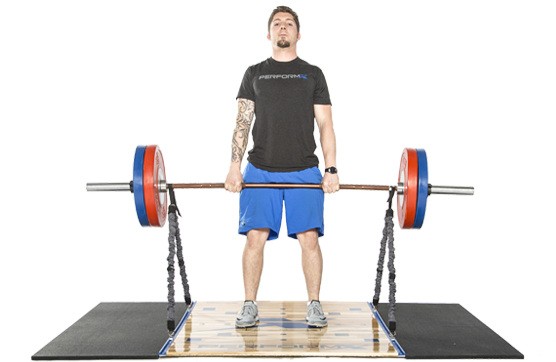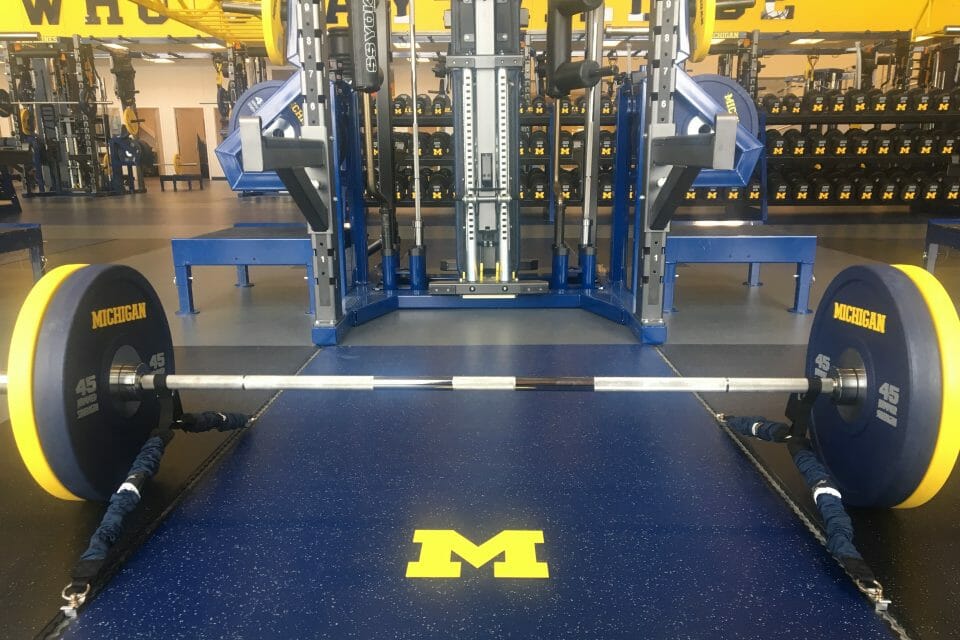FOCUS ON RESEARCH: Q&A with Dr. Andy Galpin – Effects of Elastic Bands on the Deadlift

FOCUS ON RESEARCH: Q&A with Dr. Andy Galpin – Effects of Elastic Bands on the Deadlift
This is the first of several blogs that Focus on Research. Here, we will provide a summary for the time-crunched coach, and whenever possible provide insight from the researcher(s) themselves.
Recently, there seems to be increased attention on using elastic bands for strength training. This type of training method is referred to as variable resistance training. In brief, variable resistance training causes a ‘variation’ in the load throughout the range of movement of an exercise – hence the name ‘variable resistance training’. This impacts the normal human strength curve for a specific exercise. For example, during the deadlift – the exercise of focus here – there becomes greater tension on the bands as the exercise gets easier towards the top of the lift and the band stretches.
Compared to other strength and power training methods such as plyometrics or eccentric training, there are relatively few research studies on variable resistance training. And, of those published most focus on the squat and bench press which leads us to the focus of this blog.

Acute Effects of Elastic Bands on Kinetic Characteristics During the Deadlift at Moderate and Heavy Loads Galpin AJ, Malyszek KK, Davis KA, Record SM, Brown LE, Coburn JW, Harmon RA, Steele JM, Manolovitz AD Journal of Strength and Conditioning Research Volume 30(5):1183-8, 2016
Purpose of the study: why do the study?
- Examine the acute effects of combining elastic bands and free weights during the deadlift at moderate and heavy loads. Basically, this study happened during one session – it was not a training study to examine the chronic effects or effects of training on 1RM deadlift, vertical jump or some other outcome.
Subjects and Methods: who participated and what did they do?
- Twelve trained men (average age 24 years, 5’9” 187 lbs, deadlift 1 repetition maximum (RM): 413 lbs)
- During the session, they completed 2 variable resistance (Band 1-B1 and Band 2-B2) and 1 traditional free-weight (No Band or NB) condition at both 60 and 85% 1RM on a force plate
- B1 had 15% resistance from bands with the remaining 85% from free weights.
- B2 had 35% bands with the remaining 65% from free weights.
- NB used free weights only.
- The average resistance was equated for all conditions – that is, the resistance of the overall load was the same for each lift.
The Results
- Bar velocity and power increased, whereas force decreased with the addition of bands.
- The amount of band tension (B1-15% or B2-35%) had little impact on power when lifting at 60% 1RM.
- Greater resistance from bands resulted in greater peak and relative power when lifting at 85% 1RM.
- Adding elastic bands decreased time to peak force, time between peak force and peak power, and time between peak force and peak velocity when compared with no bands/traditional free weight at 60% 1RM (NB > B1 > B2). These differences only reached significance for NB > B2 when lifting at 85% 1RM.
Conclusion
- Practitioners should consider using heavy bands when prescribing the deadlift for speed or power, but not maximal force.
- The results should be applied with caution to less-experienced lifters as the technical proficiency requirement of lifting with heavy bands is extremely high (especially at heavy loads).
Question and Answer with the author
Q1: Besides the fact that no studies have examined variable resistance loading on the deadlift (as compared to bench and squat) can you explain why you initiated this study? I’ve used different forms of variable resistance for almost 20 years and realized that little research existed, so I wanted to contribute to the literature in the hopes it gave people a better idea of how to use and implement variable resistance with the deadlift.
Q2: Why did you choose the 15% and 35% of resistance from bands? Basically to mimic previous research studies so we would have a comparison, and because they represented fairly standard loads people use when implementing heavy bands in the field.
Q3: Why use variable resistance training? Loads of reasons.
- It’s fun
- Variety
- Requires additional movement control and stability
- Allows athletes to increase load over the entire range of motion (i.e. address different portions of the strength curve)
- Helpful to teach athletes to accelerate and improve the time to peak velocity and potentially rate of force development as well.
Q4: What would you suggest as an optimal loading protocol (frequency, intensity, duration of cycle) for variable resistance training? No such thing exists. It should always depend on the individual athlete and their training experience, weekly and monthly training goals, etc. They (bands) have extreme versatility. This is where the “art” kicks in.

“Wow! That looks really cool. About time someone figured out a way to do this without having to drill holes in the ground.” – Dr. Andy Galpin
About the researcher – Andy Galpin, PhD
Andy completed his PhD in Human Bioenergetics at the renowned Ball State University muscle physiology lab in 2011 and is now a professor in the Center for Sport Performance at Cal State Fullerton. Although a diverse scholar, Andy’s research focuses upon the acute responses and chronic adaptations of human skeletal muscle in response to high force/velocity/power and fatiguing exercise from the whole body, down to the individual muscle fiber and even into the DNA level. He also hosts The Body of Knowledge Podcast, a series of 5-, 10-, and 55-min physiology lectures along with being a co-author of the book Unplugged. Learn more about Andy at andygalpin.com and Follow him on Twitter @DrAndyGalpin
Related Perform-X blogs
Cord-Loaded Dead Lifts: Tips for the Collegiate Strength Coach
Cord-Loaded Olympic Lifting: Suggestions and Key Points for Strength and Conditioning Coaches
You can’t fire a cannon from a canoe: training the lower body
The Platform: Beyond Weightlifting – the Integration of Plyometrics and Variable Resistance Loading